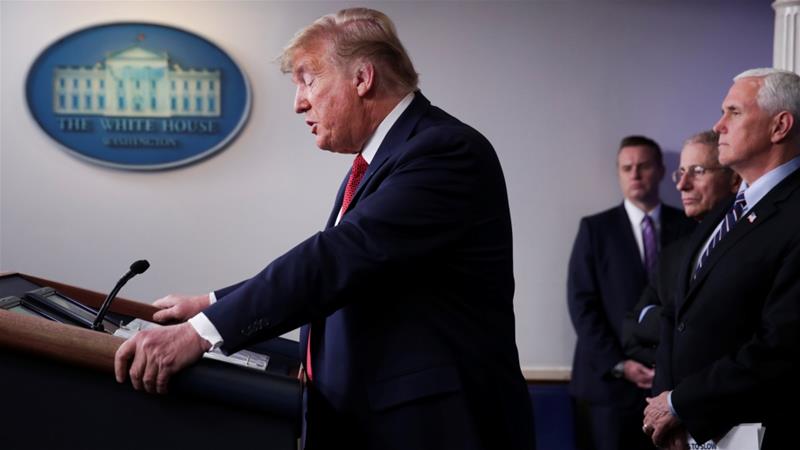Democracy & Governance
Reopening US businesses on April 12, as the US president proposes, is the wrong move -By Anthony Pahnke

It is one thing to provide hope during a crisis – it is quite another to address people’s fears with empty promises. Unfortunately, US President Trump is engaging too much in the latter and not enough in the former as the coronavirus threatens to upend the United States healthcare system.
The latest development in the president’s critically flawed response to the pandemic is the false optimism that he has created by stating that the country “could open for business” by Easter.
What the US needs, right now, is leadership. Politicians who are true leaders in times of crisis provide well-conceived plans that prioritise the most vulnerable, while also issuing clear and calming statements when discussing matters with the public.
Is this what we receive from the White House? No, far from it – when we need clarity, we get confusion, and where facts and research should provide guidance, we are told that the economy takes precedence over everything else, people included.
So, what exactly are the facts?
On this front, many of us are in the dark. To know the actual extent of the coronavirus pandemic requires testing folks who may have it. That way, we would know who is sick and where they are.
Yet, the US lags significantly behind most other countries that have been administering tests, such as South Korea.
It is unclear what the administration’s efforts have been in this regard, for instance, whether the government turned down kits from the World Health Organization (WHO), or simply was slow to get the FDA to approve an alternative.
The result, however, is that the reported number of coronavirus cases is most likely an underestimate.
Yes, we can point fingers all we want, but we cannot change the past. We can plan with whatever information we do have.
We know from existing research that approximately 15 percent of the people who are infected will require hospitalisation. For every 1,000 people who have the virus, this means that about 150 people will need to be admitted to hospital.
We also know that people above the age of 65, individuals with underlying health conditions, such as heart disease or respiratory illnesses, as well as folks with weakened immune systems, are likely to fall seriously ill if they contract coronavirus.
It is also clear that the vast majority of those who catch the virus survive – studies place the death rate at 2 percent, perhaps even lower.
Research also shows that quarantine works. That much, at least according to the United Nations, has been made clear by analysing how China has successfully brought the spread of the virus under control.
Two clear action plans result from this information – first, the government needs to act swiftly and dedicate emergency resources for healthcare. Second, politicians should clearly tell people to stay at home.
Yet, where such steps need to be taken, Trump either drags his feet or misleads.
Consider the government’s slow action with respect to the Defense Production Act of 1950 which gives the president powers to compel businesses to follow orders deemed necessary for national defence. The president signed two decrees authorising the use of this Act which would make private companies prioritise carrying out government orders. However, he took days to issue any specific orders under the Act – only doing so on Friday to compel General Motors to produce ventilators.
And why did it take so long? According to some reporting, Trump was worried about complaints from big business on how using the act would interfere with the market and private property.
There are others who would also prioritise the economy over everything else – the Lieutenant Governor of Texas, Daniel Patrick. In expressing fear over “economic collapse” and that we are “losing the whole country”, this week, he followed Trump in stating that perhaps in a few weeks people should get back to work.
Yet, it seems that the Lieutenant Governor may not be the best person to consult at times like these. He is a small businessperson – not a doctor or healthcare professional – so let’s listen to them before we open businesses and go back to living as usual.
More importantly, we are receiving mixed messages from across the country as a whole. Individual states, such as California, New York and, more recently, Minnesota, have ordered non-essential workers to stay at home. There is no expiry date set with these orders.
It seems that Trump and Patrick think that they should expire at a certain time, while state governments have a different opinion.
More importantly, what will people do? If the president and some of his supporters think it is ok to resume our typical daily routines in three weeks’ time, why not make it two? Hell, why stay home at all?
With cases rising by the thousands daily across the country, and as something like 30 percent of infected people show no symptoms according to the research, then this seed of doubt concerning the need to stay home could grow into a monster.
In effect, it could render null all attempts to contain the virus, granting the contagion fertile ground to continue to spread globally.
So, will the US be “open for business” by Easter? Is this possible? I cannot say one way or another. But really, opening or closing the US is not the issue. What is necessary is for our leaders to act cautiously, with the information that is available, to create well-thought-out plans that keep the most vulnerable among us safe.
For the sake our friends, families and also for all the other people we do not know who have heart disease, AIDS, cancer or who are our elders, the president needs to act as if their safety is the reason for his actions.
This is what a leader would do – the question is, will Trump?



















